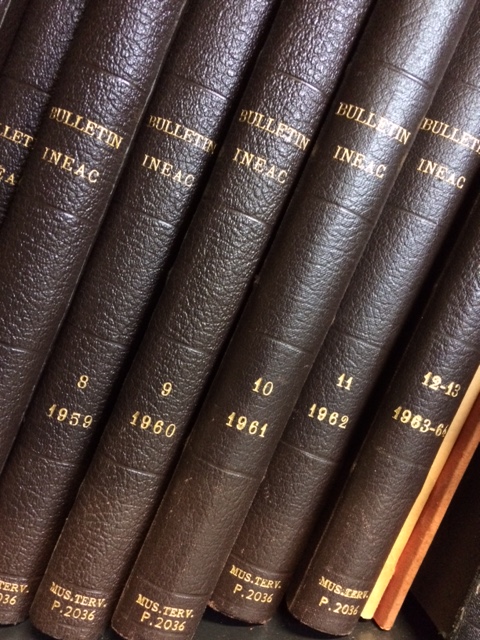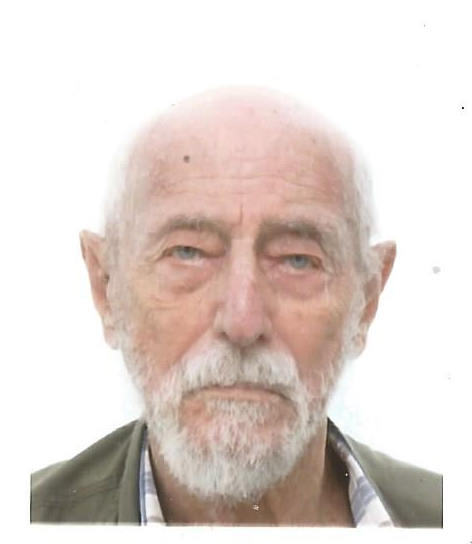Lunch with Edmond De Langhe
The COBECORE project aims to digitize data, which is currently stored in the INEAC archives. One of the biggest challenges with historical data is finding the appropriate metadata, such as protocols and other contextual information. Fortunately, INEAC followed rigorous administrative procedures and much of the necessary context is available in the archives. INEAC published prolifically, at a rate of up to 3000 bibliographic records annually. Journal articles appeared in the Bulletin Agricole du Congo Belge et Ruanda-Urundi, the Bulletin d’Information de l’INEAC, the Série Scientifique, the Série Technique, the Flore du Congo Belge et du Ruanda-Urundi, Atlas anatomique des Bois du Congo Belge, Essences forestières et bois du Congo; soil maps, vegetation maps and numerous reports (Fig. 1).
Another valuable approach to better understand the context is to talk with the scientists who actually carried out the work. In this sense, the implementation of COBECORE is urgent. Every INEAC-agronomist and researcher has since retired and most have unfortunately passed away. During the Network Workshop, we were fortunate to have two such scientists present, to talk about their time during the final years of INEAC (Prof. Em. Tillo Behaeghe) and in the years shortly after independence, when INEAC became INERA (Prof. Em. Eric Tollens).
We had also invited Prof. Em. Edmond De Langhe, but at the time of the Network Workshop he was unable to attend for health reasons. Edmond De Langhe is professor emeritus Tropical Crop Improvement at the KULeuven (Fig. 2). From 1954 to 1961, he was principal assistant at the Yangambi research centre of INEAC. He later set up the Laboratories of Tropical Crop Improvement at the University of Ghent and the KULeuven. From 1974-75 he was Scientific Director of INERA (ex INEAC) and in 1985, he became the founding director of the International Network for the Improvement of Banana and Plantain (now a division of Bioversity International, CGIAR).
And so it was, that on a cold February day, Hans Verbeeck (coordinator of COBECORE at UGent), Kim Jacobsen (RMCA/UGent), and Steven Janssens (Botanic Garden Meise) travelled to Oud-Heverlee to have lunch with Edmond De Langhe. Prof De Langhe confirmed what Prof Behaeghe had previously mentioned during the Network workshop: the annual reports will provide a lot of information, because INEAC was organized with a seemingly military discipline. INEAC followed strict hierarchical protocols, whereby each report was stored locally and copies were sent to the head quarters in Yangambi and Brussels. Still, these numerous duplications and detailed reporting procedures were only applied to official reports and publications. As Prof De Langhe pointed out, we will never be able to completely revive the ghost of INEAC, because much of the expertise and thoughts about tropical agronomy died together with the institute and it’s former employees.
However, many ideas and unpublished data may still remain in the research stations in the Democratic Republic of Congo. Edmond is convinced that a wealth of unpublished but still usefull information on many crops could be found in the archives at the INEAC centre and stations, under the form of working documents, draft notes on results of hundreds of observations and trials and interim reports. He strongly feels that, if this “grey literature” would be made available in digital form – via photocopies e.g.-, current researchers on these crops would eagerly consult it, and detect valuable information that current research is missing. Also, some of the 12 000 Congolese who were employed by INEAC at the time, may still live in the vicinity of the research stations and be able to help locate some of this information. And once again, we realize that the disclosure of these archives is urgent. Such an endeavor, while beyond the scope of the current COBECORE project, might be considered for future expeditions to the DRC.
 |
 |
BLOG
INEAC history
